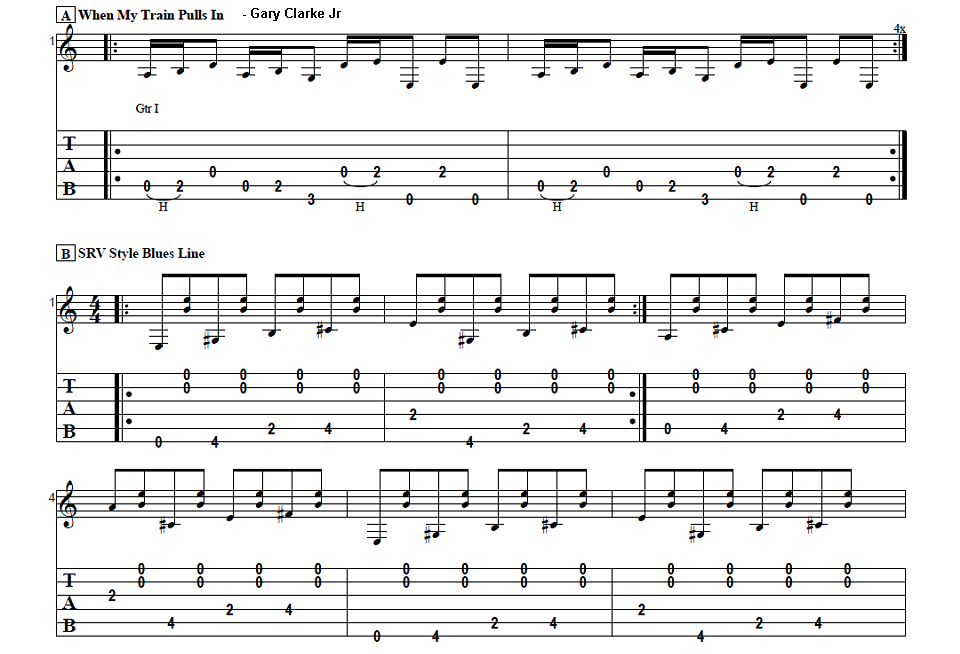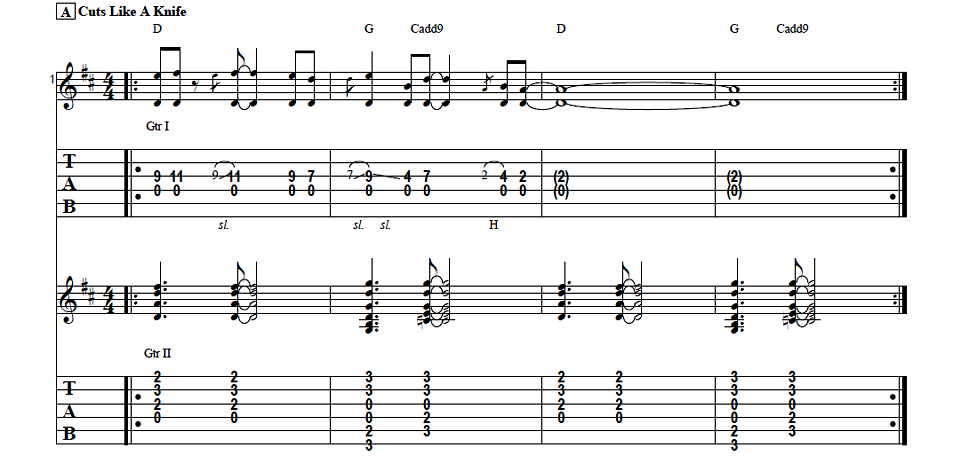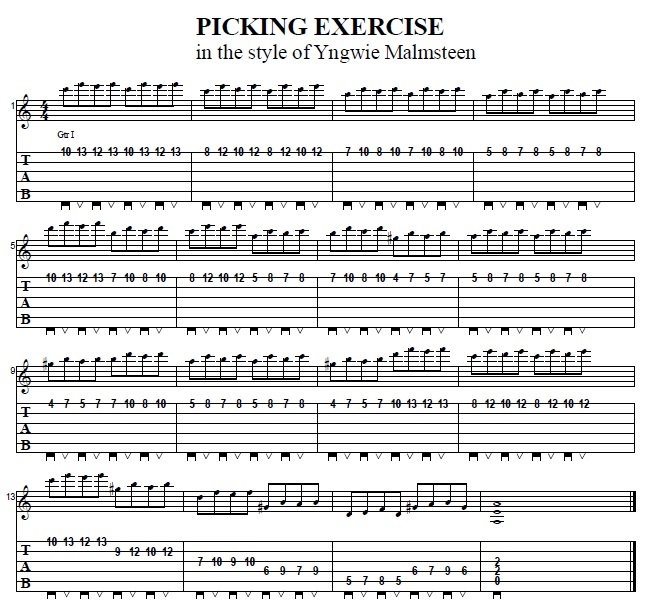Learn to play two killer modern blues riffs from Guitar Control instructor Darrin Goodman. Be sure to get the free tabs to go along with the video instruction and you will be in the blues zone tonight!


Introduction
Hey everybody how’s it going? This is Darrin with GuitarControl.com bringing you this video lesson. Today I want to show you a couple of modern blues riffs that can be altered in a whole lot of different ways to kind of make them sound different and they’re also just kind of really good exercises for a couple of different techniques we’ll be looking at. So be sure to click on the link in the description for the tabs and let’s get close up and take a look.
Modern Blues Riff-1 When My Train Pulls In – Gary Clark Jr
All right so the first one we’re going to look at is When My Train Pulls In by Gary Clark Jr. So this is just like the main riff of the song, it’s the intro and then a variation of this that he does for the verse. So this is pretty simple, it’s all just a bunch of single notes, but there’s just a whole bunch of variations that you can do with it. All right so we start off we’ve got the open A string and then we’re going to do a hammer-on to the second fret. Now I’m using my second and third finger to play this, you could use your first and second if that’s easier for you, but I’ve just had a lifetime of playing that if I’m on the first fret it’s my first finger and so on and so forth, this is just the way that I’ve played it. So we play the A string open and we do a hammer-on to the second fret and then we follow that with the D string open and that’s your first beat, so these two are 16th notes and then this one’s an eighth note… And then starting on beat number two we do the open A string to the second fret again, but this time he doesn’t do a hammer-on, he just picks it to the third fret of the low E string and that’s your first two beats. Then we’re going to go to the D string open and we’re going to pick that and hammer to the second fret, those are 16th notes and then we follow that with the open low E string as an eighth note and then we go back to the second fret of the D string for the downbeat of four and then on the end of four the open low E string. So this riff is written as two measures, but they’re both the same thing and it just he just repeats that like numerous times… So that’s one measure, so one e and two e and three e and four and… Now you can change that up by you know hammering all of it or pick it all… however you kind of want to do it so you can mix it up and if you’ve watched any videos of him playing this live he kind of mixes it up when he plays it live…
Modern Blues Riff-2 Blues Bassline In The Style Of SRV
All right so the next one I want to look at is a walking bass line, but we’re gonna be playing it on guitar. So it’s entirely made up of eighth notes and the bass line notes will be on all of the down beats, so on one two three four and then on the ands, the off beats, we’re going to just play the B and E strings open; so it’s like every other note. So we start off with the open low E string and then on the and, so it’s like one and. Now the bass line itself we can just go over that first and then we can add the ands in there. So starting on the low E string it’s open and then to the fourth fret, I’m using my third finger, then to the second fret of the A string to the fourth fret of the A string with my third finger to the second fret of the D string… then back to the fourth fret of the low E string and then to the second fret of the A string and then the fourth fret and then it would repeat and that’s basically the baseline for the entire thing, except when it switches. So this is the one chord this is like a 12 bar blues format so for the one chord it’s revolving around E and then for the four chord it’s going to revolve around A; so we’re going to take that same bass line, but we’re just going to move it up. So here we’ve got the E string and the A string and then the D string back to the E string back to the A string… Okay and then when it goes to the four chord we’re just going to do that same sequence, but it’ll now it’ll be strings; A, D and G. So we start off with the A string open to the fourth fret then to the second fret of the D string to the fourth fret of the D string to the second fret of the G string back to the fourth fret of the A string and then to the D string second fret and then fourth fret… All right so then when it goes to the five chord it’s a little bit different and we’ll take a look at that in a minute. So like O said you’re going to be doing that baseline; one, two, three, four and then on the ands we’re going to be playing the B string and the high E string together open. So how I’m doing this is I’m using the hybrid picking technique, so I’m playing the bass line with the guitar pick and then I’m using my second and third fingers to play the B and E strings open on the off-beats. Now if you’re fairly new and you haven’t really worked with hybrid picking it can be kind of tricky at first. So an alternative way you could do it is you could just use your thumb to play the bass line… I just like to use the hybrid pricking technique so that way I have that pick available if I want to end up playing some licks or something in between some of the lines. Okay so we’re gonna go one and two and three and four and, so that’s the first measure. Okay so then on the second measure we start on that second fret of the D string back to the fourth fret of the low E string… to the second fret of the A to the fourth fret of the A and that’s the first two measures. And then it shows that it’s repeated because it’s going to be just like a regular 12 bar we’re gonna have four bars of the one chord and then two bars of the four chord two bars of the one chord one bar of five one bar of four and then back to two bars of one or a turn around… All right so then moving on to the third measure we’re just going to move it up a fourth so now we’re going to start with the A string open to the fourth fret of the A string to the second fret of the D string fourth fret of the D string and that’s the third measure… Then starting on the fourth measure second fret of the G string, back to the fourth fret of the A string, back to the second fret of the D string, back to the fourth fret of the D string… and that’s two bars long and then we’re back to the root position… and then back to the one chord… so that brings us through measure six… So after that it’s going to bring us to the five chord and for the five chord the bass line is a little bit different. So we’re going to start on the second fret of the A string because our five chord is based around B, so we’re gonna have second fret of the A string, first fret of the D string, fourth fret of the D string and first fret of the G string. So this involves a little bit more stretching… and then the next measure open A string to the fourth fret to the second fret of the D string to the fourth fret of the D string… and then back to the original one chord line; so open low E, fourth fret, second fret of the A string to fourth fret, second fret of the D string back to the fourth fret of the low E to the second fret of the A… and then the fret of the A. So this is very similar to Pride and Joy by Stevie Ray Vaughan, but not exactly what he’s doing, this is just kind of in the style of that song. So the whole thing…
Conclusion
All right so there you have it, two not too terribly difficult, but really good sounding blues riffs that are kind of like a blues bass line but on the guitar. So if you like this lesson be sure to give me a thumbs up and leave a comment down below if you have any questions about this or other guitar related topics. If you’ve not already done so please subscribe to the channel and hit that notification bell so you don’t miss any of the content that we upload throughout the week. Well that is all I have for you today. Thanks for watching and have a great day.




